While plans for a luxury hotel and condo tower designed by Renzo Piano Building Workshop and Mark Cavagnero Associates were previously approved and permitted to rise up to 405-feet in height at 555 Howard Street, the 69 condos which were to top the development have since been eliminated from the plans, a move which shouldn’t catch any plugged-in readers by surprise.
The modified plans would yield an additional 164 hotel rooms (for a total of 401). And while the envelope and design of the tower remain roughly the same, the building’s quadruple-height lobby and restaurant space fronting Howard Street, along with the approved streetscape for the development, have been modified.
The tower’s Tehama frontage has been slightly modified as well and the adjacent “Under Ramp Park” component of the project now includes a more distinct terrace for the tower’s lobby restaurant, bordered by an “urban garden” POPOS.
And yes, building permits for the modified project have been requested but are dependent upon the modifications being approved by Planning, the application for which is under review.
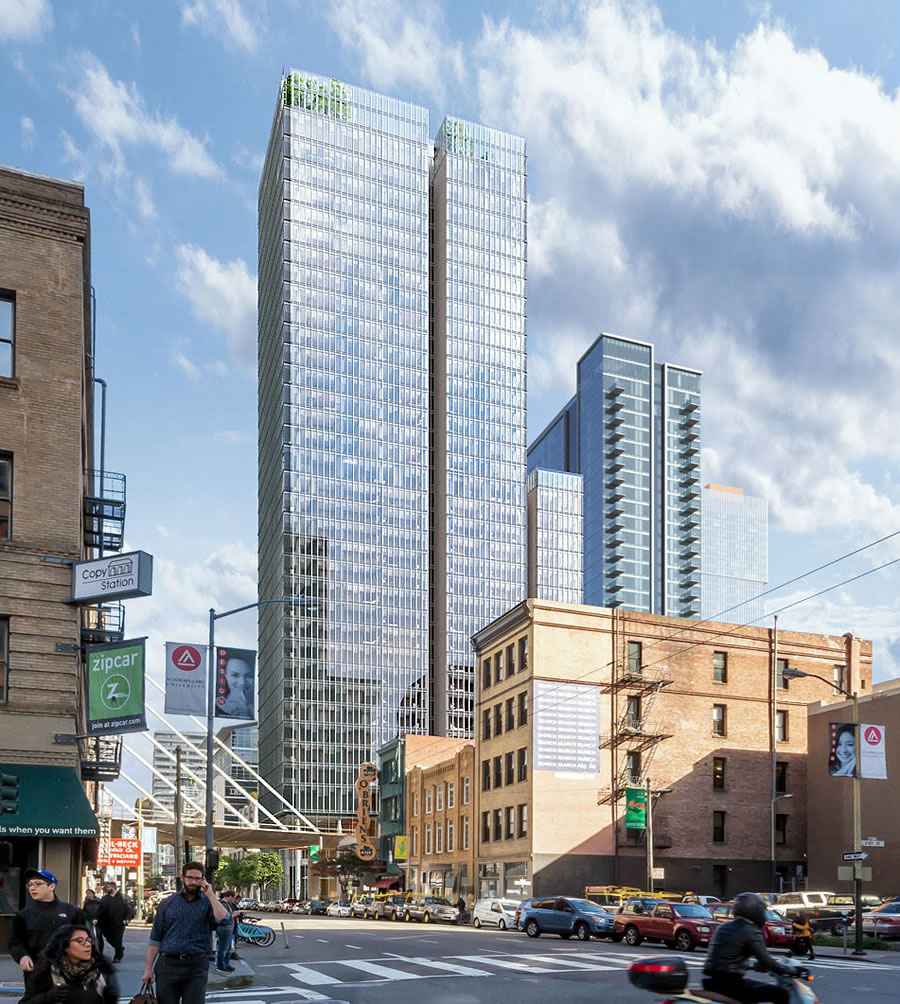
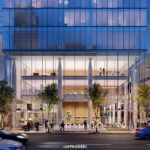
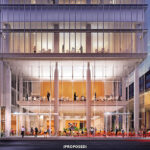
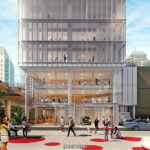
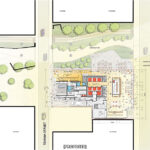
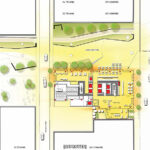
Yes, what we desperately need right now is more hotel rooms. We certainly don’t have a housing crisis.
Maybe the voters should have considered this when passing laws which made housing economically infeasible.
And yet, there are now over 10,000 units of housing under construction across the city, which is 26 percent more than at the same time last year, nearly 70 percent above the average number of units under construction across the city at any point over the past ten years and the most in over a decade.
And yet, this is less than need and less than we’ve had under construction in prior decades.
“Jake T” is spot on.
From 1945 to 1979, the population of SF was in continual decline (825K down to 690K), but we were still producing housing at the abundant rate of 3200 units per year. That’s why housing was broadly affordable to the middle-class as well as the various waves of counter-cultural types arriving to the City during this timeframe e.g. beatniks, hippies, gays, etc.
Conversely from 1980 to the present, the population of SF has been continually increasing (it’s now around 895K), yet during this period we averaged less than the meager rate of 2000 units per year. That’s why, year-in-and-year-out, during this period the cost of housing started to rise ever-increasingly beyond the cost-of-living and general wage growth.
Accordingly, since 1980 (thanks to rise of NIMBYism, and the resulting citywide down-zoning in the 70’s and an ever increasingly anti-housing regulatory regimen) we have been chronically under-producing housing relative to increasing demand — which has led directly to the massive housing shortage and the resulting skyrocketing costs that we are currently suffering from.
The only way to solve this crisis and still have a City that is affordable to the middle-class is to (massively) increase housing creation.
The current pace of development and actual building in San Francisco is actually higher, not lower, than in prior decades.
or Karl, maybe it isn’t the housing production that is the problem and the problem rather is the increasing population
While Karl is sort of right below about building housing while the city’s population was falling resulting in affordable housing prices: The pace of building in the 50s thru the 70s is less impressive once you net out the units demolished under urban renewal. Thousands of units were demolished. While the basic storyline is true I believe, the net (as opposed to gross) housing construction from that time is not necessarily that much greater, if at all, than the current rate during the 2010s. I think the big driver of more affordability in the mid-20th century was the depopulation of the city.
Sorry Karl, twisted logic on the population.
The 1945 population count is not official US Census. It was conducted during WWII and included the temporary surge of people in the military and industries with ties to the military such as shipbuilding. Although some of those people did remain in SF, some returned home and some filtered out to the suburbs. Using that 825K distorts things.
A more accurate comparison is to use the 1940 to 1980 population increase – 635K up to 679K
Right church, wrong pew; even negating the WWII anomaly, Karl’s point that SF’s population declined for a third of a century is correct…but it’s also not really relevant: it’s not population, ‘per se’ that determines housing demand, it’s the number of households. And since the average household size declined by about a third since we were liking Ike – i.e. more than the loss in population – potential demand likely increased.
continuing…..
A lot of the new housing produced in the period 1946~1965 were single family residences, in new neighborhoods. In those days, large tracts of land were still available, and builders like Sunstream Homes, acquired these parcels, laid out the streets, installed utilities and built the houses. Neighborhoods like – Lakeshore, Forest Knolls, Miraloma Park and Midtown Terrace are the work of Sunstream. Diamond Heights is another example, which had a number of different builders including Joseph Eichler.
Keep in mind also, that individual housing units (existing and new) tended to accommodate more people during that era. A house or a flat might have 2 adults plus 2-4 children. Today those same units are often occupied only by a couple.
The housing crisis is a lack of homes affordable by regular folks. Condos here wouldn’t have helped that.
Eh…what about owners that have tenants in to pay their mortgage? I just moved from a room in Dogpatch, wasn’t exactly cheap but takes demand off the lower-cost housing when the economy’s hot.
Right now I expect a shift in tenancy of cheaper housing from folks in the service sector to those that can WFH and want to be cautious / catch a bargain. Personally I worry that will have long-term repercussions. Prices going down will lure some young people back in but I think it’ll be a mixed bag.
Where do you think millionaires live when there’s a shortage of housing at every level? The previously “affordable” Victorian flat after using an Owner Move-In eviction to remove a 6-member family on rent control. The more apartments/condos we have at every price point, the better.
This is cleaver pro-developer rhetoric, but false. I suggest you take a look at the MLS, there is no shortage of housing available to and affordable by millionaires in S.F. (or anywhere else in the Bay Area, for that matter). The shortage is for housing affordable by households with income from jobs that pay around the median household income.
No, its demonstrably true.
Every neighborhood in SF that has stymied the creation of new housing is thoroughly gentrified (e.g. Noe Valley, Cole Valley, Haight Ashbury, etc.)
Enough of your anti-housing, economically-ignorant nonsense!
@Karl–Gentrification has occurred in San Francisco in neighborhoods with little or no development as well as neighborhoods with lots of development (South of Market, Mission Bay, Dogpatch, Potrero Hill, among numerous others). San Francisco is just becoming gentrified. Developers don’t build housing for regular people because those customers aren’t as profitable to serve.
Housing built for rich people does not cause a “trickle-down” effect to the barristas and teachers. It never has. It just creates more demand from rich people who want to move-into the area.
In fact, the average sale price per square foot for the San Francisco neighborhoods in which the most new housing has been built over the past decade is currently running 18 percent (Mission Bay) to 30 percent (Rincon Hill/Transbay) higher than citywide.
Millionaires tend to be able to afford whatever they like. The point is, not building housing hasn’t stopped gentrification either or helped the middle class at all unless they already owned their house or have rent control and were able to stay in the same unit for a very long time. If, for some reason I lose my rent controlled apartment, I am f****d because I am surely not going to be able to afford $50,000 a year in rent. As a native, I blame all of the poor policy and zoning restrictions and the ridiculous CEQA requirements for this. And pretty much all of the affordable housing units going up are funded by units developed for the millionaire class. So now we’ve made ourselves reliant on the upper class to house ourselves. Bravo!
The fact of the matter is, when you add up land costs and construction costs, plus entitlement “impact fees”, the cost to produce a unit of housing without government subsidies is outside the grasp of anything referred to as “affordable” on this site. As a case in point, the city’s own project at 16th and S. Van Ness has a combined land plus construction cost of around 900k per unit, for permanently affordable housing – and this doesn’t include a markup for profit to sell. You just can’t build units in SF that would sell for under 500k (still a lot, I know) without government subsidies. It’s not the developers fault, it’s simply economically infeasible. SF has the highest residential construction costs in the world currently.
The root of the problem: The rich have become too rich.
Some would argue that the dearth of hotel rooms and airbnb-ification of the city contribute to the housing crisis. Adding hotel rooms isn’t necessarily contrary to solving a housing shortage in the age of a ‘sharing economy.’
In normal times, yes. When the majority of our hotels are closed because of a plague, not so much. 🙁
since this will take years, its fair to say said plague will be eradicated
Giving the forthcoming tech crash and an anticipated continued dearth of tourism, is there as much of a need for either? (COVID is already spiking badly in states eager to “reopen” their economies. I anticipate similar here)>
You’re gonna need to be a little more detailed with that evaluation. Because as it stands it’s overly vague, and what can be gleaned from it is ahistorical. And is everyone just ignoring that projects that are in planning and design right now won’t be ready for years? They won’t be coming online during this exact moment of the downturn and you can’t reasonably assert that there will never be a rebound.
Yes, we still have 8K+ homeless in SF alone, and the more high end housing we get, the more vacancies we have in our rent-control housing stock. It’s all related.
The housing has been eliminated for this development.
“Our rent controlled housing stock” You seem to think private property belongs to the public……It does not. It’s not “ours” or “yours”, unless your name is on the deed.
Building high-end housing doesn’t necessarily cause residents of rent-controlled units to vacate those units. As people have moaned about here, over and over, some people of relative means prefer to stay indefinitely in rent controlled units at very low rent. Rent controlled units will always be in shortage here.
It is *not* all related. I know they teach that in Econ 101 but it just isn’t as simple as that.
If it’s not as simple as that, then what is the answer?
We know that housing aimed at the top end of the market is the only type that ‘pencils’ or pays for itself. What is your suggested response?
Do we not build housing? Do we build subsidized housing so that a tiny subset of those who need lower housing costs receive it?
The whole issue about a lack of new housing inventory keeping people away from cities with lots of job opportunities is part and parcel with the poverty and associated negative socio-economic outcomes about which people are rioting.
Want a better life? You should move to a city with lots of jobs and work hard, but there’s nowhere to live(!)
The best way to be an ally to poor people who need to improve their lives is to get on board with adding lots of housing which means relaxing a lot of zoning. And build hotels (so that tourists don’t displace residents).
Permits may have been requested but this will not break ground, if it ever does, until the end of the 3 year permit window. There is no way the need for more hotel rooms can be judged at this time. Especially with a potential second wave of the virus coming per latest stats.3 years from now things should have settled out. Another factor is that HSR is not coming to the TTC in our lifetimes if ever. The budget collapse of the state, counties and cities probably pushes off Caltrain getting to the TTC for an additional decade or more. Tech jobs leaving the city in the coming years are another factor. Business travel will likely not be as it once was. There are several fairly large hotel proposals in the pipeline (including Parcel F) and it is hard to see any forward movement on those projects for a long while.
Dave, you have absolutely mastered the art of making predictions that are hyperbolous and that have been repeatedly proven wrong over the years. You are literally claiming, and have forever, that tech is going to permanently implode, there’s going to a massive exodus of population, and that there is no demand (and hasn’t been and won’t be) for housing and hotel space — at least not demand for any of the projects you subjectively dislike.
At what point does being constantly proven wrong by observable reality clue you into the idea that maybe your priors are just bad and not evidence based?
ha thanks for this 😛
Hey, give a master his due…right?? But if we may actually get back to the specifics of the project; despite the title “…closer to reality” I would argue it’s actually further away than it was a few months ago: permits are nice, but they don’t actually build anything. Money does; in addition to talking and rooting evil, it makes possible cranes rising and ironworkers double-parking their 4x4s. And at the moment, those killjoys known as lenders, despite being encouraged to open the window (as wide as possible) and toss away (as far and wide as possible) might still have pause about financing something that’s dependent upon the recovery of the segment that least likely to do so first…
Indeed. The “plan” is playing out as I suspected – just maybe a bit faster. I got out of California rental real estate around 2015. it seemed to me the days of large appreciation would be coming to an end and the difficulty of being a small time landlord in Cali would get worse. And that appreciation would level off to national levels (give or take) as I’ve “predicted” here which indeed has happened and that was prior to the pandemic. An exodus of population – yes. Massive – no. Looking for SF’s population to settle in at a more sustainable 750K. I don’t think tech will implode just that the concentration of tech jobs in the Bay vs other metros will shrink – relatively. That is the macro trend some of us have been calling for several years now. The pandemic is an unforeseen black swan which, with tele-work, will expedite the shift away from the Bay and especially SF. The hotel/hospitality industry is a big unknown right now and may be so for a while. You are so right – money and specifically loans drive major developments – indeed make them possible. This project will be in indefinite limbo because of that. More dicey is Parcel F – not just hotel (1/3), but also condos (1/3). Well, kudos to the City for squeezing a great price (ouch!) out of the developer who apparently was caught up in some form of irrational exuberance.
The real question is whether VCs will leave the Bay and they really don’t have any economic impetus to. The clustering effect may stay pretty strong then. What’s more, travel will be harder in the near future, which may discourage a move away from cities.
How can it be playing out faster than you expected if you got out of rentals in 2015. Didn’t you get out because you thought that was the peak? You missed some great years of collecting high rents with low interest rate mortgages
@sparky-b I wasn’t trying to time the market. That is very hard to do.. I saw a coming significant slowdown in appreciation in SF and California and so did tax free exchanges to other states. The places I exchanged to offered significantly better ROIs and are more landlord-friendly locales.
“the days of large appreciation would be coming to an end” —
Well, thank god for that. Increased housing costs come on the backs of people who are working and need housing, and largely benefit “investors”, i.e. rent-seekers. The best thing to happen to California’s economy, and residents’ quality of life, would be a long, sustained decline in property values.
Would not a long term flattening of values achieve the same effect, with less hysteria?
You need the hysteria to make any real progress. Just look at BLM.
Personal anger issues maybe getting displaced toward your always making personal attacks against strangers?
Or maybe I justifiably hate people lying and insisting that their disproven opinions are fact. If you think pointing out objective dishonesty and counterfactual assertions constitutes a “personal attack”, then you’re beyond reaching.
But it’s still quite telling that your advice is to “see a therapist” based on some wrongly perceived personal attack when you’ve quite literally come for the sole purpose to baselessly conjecturing that I have anger issues. It’s comically lacking in self-awareness.
Nah. It’s you. You could benefit by some sort of psychotherapy. Good luck!
Just more anger from the same source!
Your unsolicited advice and evaluation of my mental state, of which you have precisely zero knowledge, has been been noted and ignored. It’s not at all telling (sarcasm) that you can’t seem to distinguish attacking a position from attacking a person. I don’t know Dave or anything about him personally. He’s probably a nice enough guy and I’m sure there are lots of things we agree on (in fact, I can recall several). That doesn’t mean that he hasn’t been very wrong about a lot of different projects after being extremely sure that his positions and assertions were absolutely correct. Nobody’s gonna get everything right, either in terms of subjective opinion or claim of fact. But it’s not exactly controversial to point out that someone has been repeatedly, disproportionately, and demonstrably wrong on a factual basis.
But hey, keep projecting, implicitly defending counterfactual assertions, and making ACTUAL personal attacks about the mental state of people you’ve never met. Surely that will work out great! Good luck!
Agreed.
Right after the 1918 Influenza Pandemic**, urban America enjoyed one of its strongest periods of growth and prosperity, i.e. the “Roaring Twenties”.
(** Which, incidentally killed an estimated 675K (0.66%!) Americans out of a total population of 103M vs. Covid 19 which has killed only 115K (.035%) out of a population of 331M. Nearly 19 times as many people relative to population.)
All the Malthusian anti-urban hysterics and baseless projections are simply ridiculous.
This time, the difference is technology. In the 20th century, folks flocked to urban centers to work in factories, offices, commercial hubs, etc. Now, many can work remotely, order things online, and live farther away from urban cores. There will always be a pendulum swings from cities to suburbs and back, that’s only natural. But cities are not the one and only choice they were in the earlier parts of the 20th century.
“…Covid 19 which has killed only 115K (.035%) out of a population of 331M. Nearly 19 times as many people relative to population [compared to the 1918 epidemic].)”
So far. The wildfire isn’t over yet and there’s still a lot of dry fuel for a flare up, especially in California.
I don’t think that Covid-19 will have a longstanding impact on the economy though we’re clearly not yet safe.
The last image you show is the image off of Tehama. The elevated roadway provides a clue in addition to the street width. There’s another image in the current planning submittal that shows the revised design. I hope this gets built. Looks like a beautiful project.
Yes housing would be great, but housing by Renzo Piano would never be affordable irrespective of the inclusionary fees.
The Tehama image we provided in the second gallery above is the modified design.
architects need work, too
Why has the parking lot at Howard & 2nd St (shown in the lower right corner of this post’s 1st picture) never been developed? It’s zoned for 350ft. Does the [zoning] economically preclude any development due to a high potential acquisition price for the lot? Or is there a planning application somewhere in the ether that I’ve missed? Thanks.
See: Redevelopment of Prominent Parking Lot Parcel Delayed
Thank you for digging that one up!
UPDATE: The refined plans for the condoless hotel tower to rise at 555 Howard Street, as outlined above, are now slated to be approved by San Francisco’s Planning Commission tomorrow afternoon.